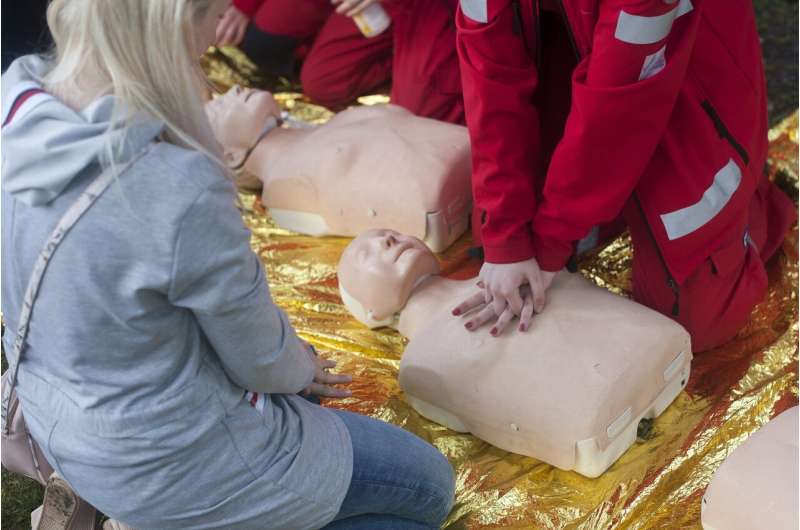
A technique frequently portrayed in dramatic resuscitation scenes in television and film is among several alternative methods to CPR that have shown no benefit in saving lives in a review by University of Warwick researchers.
The systematic review reinforces cardiopulmonary resuscitation (CPR) as the ‘gold standard’ technique when health professionals or members of the public are attempting to resuscitate someone in cardiac arrest.
The article, published in the journal Resuscitation, is the first comprehensive systematic review of evidence on the effectiveness of three less-used resuscitation techniques: cough CPR, percussion pacing and precordial thump. The precordial thump, in which a patient is struck on the chest in the hope of restarting the heart, has often been used in dramatic scenes in TV and film, such as in Grey’s Anatomy and Lost.
The researchers from the Warwick Clinical Trials Unit analysed data from 23 previously published studies that examined the effectiveness of the three techniques. The research examined precordial thump, in which a rescuer will make a firm strike to a patient in cardiac arrest in the lower half of the sternum; percussion pacing where a less forceful, repetitive and rhythmical impact is made to the left sternal edge; and cough CPR—a misnomer as it does not involve CPR—in which an individual coughs forcefully if they feel they are about to collapse.
Although popular media and social media frequently portray these techniques positively, researchers conclude that there is no benefit to using any of the three techniques either in hospital nor outside of it. In particular:
- Use of the precordial thump may actually increase risk to the patient
- Social media reports on ‘cough CPR’ erroneously confuse cardiac arrest (when someone has collapsed, is unconscious and unresponsive and is not breathing) and heart attack (which typically presents with chest pain when blood supply to the heart is insufficient) and—potentially dangerously—advocates for the person driving to hospital whilst continuing to cough. Anyone who thinks they may be having a heart attack or has concerning chest pain should seek immediate medical attention.
The research team concludes that this reaffirms CPR as the ‘gold standard’ in the situation of a cardiac arrest, as recommended by Resuscitation Council UK and resuscitation experts worldwide. Both health professionals and members of the public should prioritize it when faced with an individual experiencing a cardiac arrest, rather than be delayed with the use of other techniques.
It is vital that the person in cardiac arrest receives CPR, which is a skill everyone should be encouraged to learn. Every minute without CPR and early defibrillation can decrease someone’s chances of survival by up to 10%. Resuscitation Council UK Guidelines stress the importance of prompt action with CPR and early defibrillation as being vitally important to giving someone the best chance of survival.
Lead author Dr. Christopher Smith, a clinical lecturer at Warwick Medical School and an Emergency Medicine doctor said: “People need to continue doing the basics: if someone collapses you should call 999, start CPR, and if someone else is present they should find a defibrillator. Those who have chest pains and are unwell need to seek medical advice without delay. Early intervention by members of the public has the biggest impact on survival.
“The effectiveness of these techniques have been considered in international resuscitation guidelines, but this is the first time they have been comprehensively studied in a systematic review. They are not established practices but were at one time advocated and have since fallen out of favor. Some of these techniques are still being used around the world and with this research can confidently say they are of no benefit to patients.”
Sue Hampshire, director of clinical and service development at Resuscitation Council UK said: “Prompt action when someone has collapsed and is not breathing normally is crucial to the person’s chances of survival. There isn’t time for confusion. So, we believe it’s vitally important that as many people as possible know how to spot if someone has collapsed and stopped breathing normally, so they act quickly by calling 999, starting CPR and accessing a nearby defibrillator.
“We want everyone to learn the simple steps to perform CPR that will give somebody having a cardiac arrest their best chance of survival, whilst reducing the risk of COVID-19 transmission from performing CPR.
“During this time when COVID-19 is widespread within the community we advise some modifications to standard CPR techniques. Loosely lay a face covering, (such as a mask, cloth, towel or item of clothing), over the mouth and nose of the person who has collapsed, do not put your face next to theirs when checking for breathing and do chest compression only CPR (no mouth-to-mouth rescue breaths).
“You can find out more about how to keep yourself safe while doing CPR by visiting www.resus.org.uk/watch. Your quick actions could be the difference between someone living or dying.”
Source: Read Full Article
